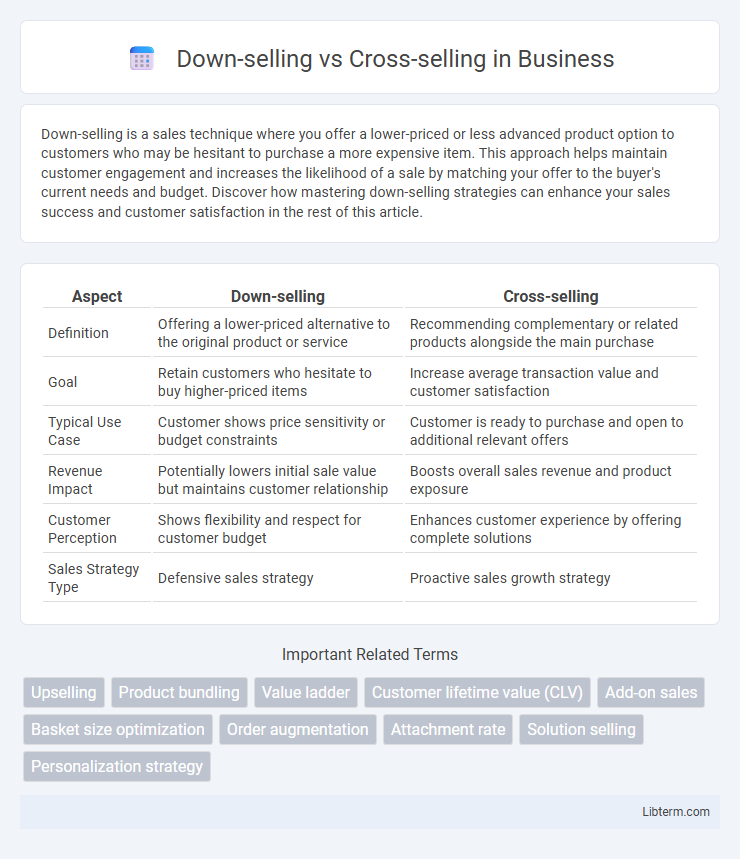Down-selling is a sales technique where you offer a lower-priced or less advanced product option to customers who may be hesitant to purchase a more expensive item. This approach helps maintain customer engagement and increases the likelihood of a sale by matching your offer to the buyer's current needs and budget. Discover how mastering down-selling strategies can enhance your sales success and customer satisfaction in the rest of this article.
Table of Comparison
| Aspect | Down-selling | Cross-selling |
|---|---|---|
| Definition | Offering a lower-priced alternative to the original product or service | Recommending complementary or related products alongside the main purchase |
| Goal | Retain customers who hesitate to buy higher-priced items | Increase average transaction value and customer satisfaction |
| Typical Use Case | Customer shows price sensitivity or budget constraints | Customer is ready to purchase and open to additional relevant offers |
| Revenue Impact | Potentially lowers initial sale value but maintains customer relationship | Boosts overall sales revenue and product exposure |
| Customer Perception | Shows flexibility and respect for customer budget | Enhances customer experience by offering complete solutions |
| Sales Strategy Type | Defensive sales strategy | Proactive sales growth strategy |
Understanding Down-selling and Cross-selling
Down-selling involves offering a lower-priced alternative to a customer who may hesitate to purchase a more expensive product, aiming to secure a sale while maintaining customer satisfaction. Cross-selling targets increasing the total purchase value by suggesting complementary or related products alongside the primary item. Both strategies optimize revenue by addressing different customer needs and purchasing behaviors within the sales process.
Key Differences Between Down-selling and Cross-selling
Down-selling involves offering a lower-priced alternative to meet a customer's budget or needs, while cross-selling encourages the purchase of complementary or related products alongside the primary item. The key difference lies in down-selling aiming to retain the sale by reducing cost, whereas cross-selling enhances total transaction value by suggesting additional items. Effective sales strategies leverage understanding customer intent to decide between down-selling or cross-selling to optimize revenue and customer satisfaction.
Benefits of Down-selling in Customer Retention
Down-selling offers significant benefits in customer retention by providing tailored solutions that better match the customer's budget and needs, preventing potential churn due to price resistance. It enhances customer satisfaction through personalized options, fostering trust and long-term loyalty by demonstrating flexibility and attentiveness. By maintaining engagement and reducing the risk of losing customers, down-selling contributes to sustained revenue and stronger customer relationships.
Advantages of Cross-selling for Revenue Growth
Cross-selling enhances revenue growth by encouraging customers to purchase complementary products, increasing the average transaction value and maximizing customer lifetime value. It leverages existing customer trust to introduce related products, boosting sales without the high cost of acquiring new customers. By effectively tailoring recommendations based on customer preferences, businesses can improve customer satisfaction and foster long-term loyalty.
When to Use Down-selling in Business Strategies
Down-selling is strategically used when a customer shows hesitation or resistance due to price or product fit, offering a more affordable or simplified alternative to maintain engagement and increase conversion rates. Employ down-selling when the primary goal is to salvage a sale that might otherwise be lost, particularly in markets with price-sensitive consumers or competitive alternatives. This technique enhances customer satisfaction by aligning offerings more closely with customer needs and budget constraints, ultimately fostering loyalty and repeat business.
Ideal Scenarios for Effective Cross-selling
Effective cross-selling thrives in scenarios where customers exhibit clear interest in complementary products or upgrades, such as when purchasing electronics with accessories like cases or warranties. Retail environments benefit when sales associates identify opportunities to enhance customer satisfaction by suggesting relevant add-ons that enhance the initial purchase value. Online platforms leverage user data and browsing behavior to dynamically recommend products that align with the buyer's preferences, increasing average order value and customer loyalty.
Common Challenges in Down-selling and Cross-selling
Common challenges in down-selling include overcoming customer resistance due to perceived inferior value and managing the risk of damaging brand reputation by appearing to push cheaper or less effective solutions. Cross-selling difficulties often arise from inadequate customer data integration, leading to irrelevant product recommendations and reduced conversion rates. Both strategies require precise customer insights and personalized communication to effectively balance sales goals with customer satisfaction.
Best Practices for Implementing Down-selling Techniques
Effective down-selling techniques focus on understanding customer needs to offer lower-priced alternatives without compromising value, enhancing customer satisfaction and retention. Personalizing product recommendations based on purchase history and preferences encourages customers to consider more affordable options while maintaining brand trust. Clear communication about cost savings and product benefits helps customers feel informed and confident, minimizing the risk of cart abandonment.
Proven Cross-selling Strategies for Higher Conversion
Proven cross-selling strategies for higher conversion include personalized product recommendations based on customer purchase history and behavior analysis, which significantly enhance relevance and increase average order value. Implementing targeted upsell prompts during the checkout process and offering bundled discounts encourages customers to buy complementary products, improving conversion rates. Utilizing AI-driven tools to identify optimal product combinations and timing these offers strategically within the sales funnel further boosts cross-selling success.
Measuring Success: Down-selling vs Cross-selling Metrics
Key metrics for measuring down-selling success include customer retention rate, average revenue per user (ARPU), and churn rate reduction, reflecting how effectively lower-priced alternatives maintain customer engagement. Cross-selling success is best evaluated through metrics like attach rate, basket size increase, and customer lifetime value (CLV), indicating how well additional products or services are adopted. Analyzing these distinct metrics enables businesses to optimize strategies for revenue growth and customer satisfaction.
Down-selling Infographic

 libterm.com
libterm.com